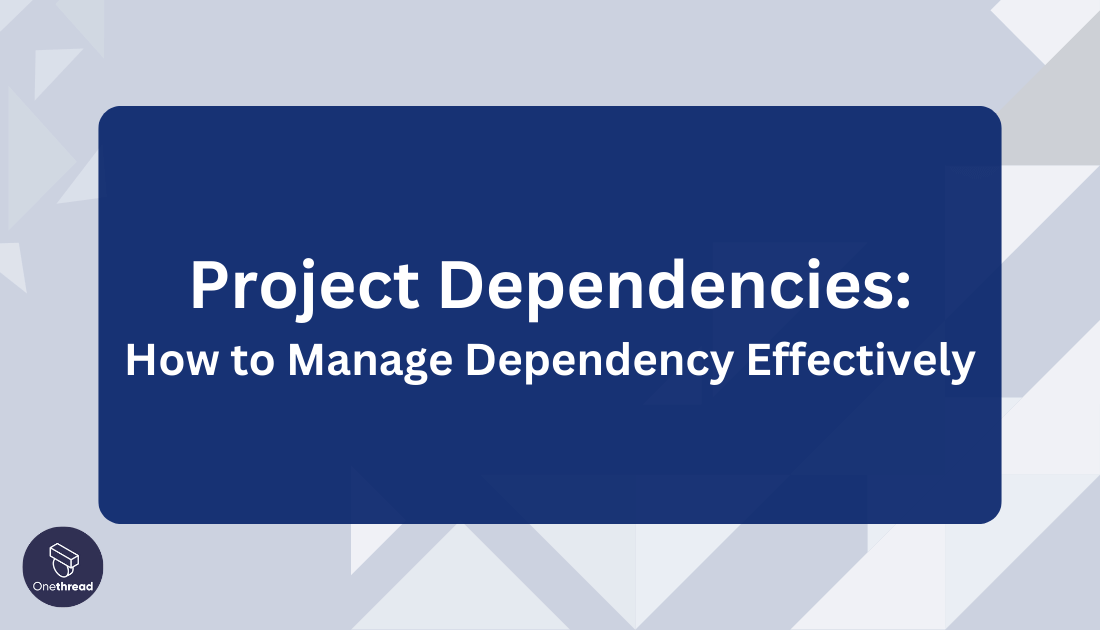Are you struggling to keep your projects on track? One of the key factors that can make or break a project is understanding and managing its dependencies. Project dependencies refer to the relationships between tasks or activities within a project, where the start or completion of one task depends on the successful completion of another.
In other words, certain tasks cannot be started or completed without first addressing their dependencies. Understanding and effectively managing project dependencies is crucial for ensuring smooth workflow and timely delivery.
In this article, we will explore the world of project dependencies and various aspects of it such as types of dependencies, identifying and mapping them, managing dependencies in project planning, allocating resources, setting timelines, and promoting effective communication and collaboration.
So let’s dive in and unravel the mysteries behind project dependencies!
What Are Project Dependencies?
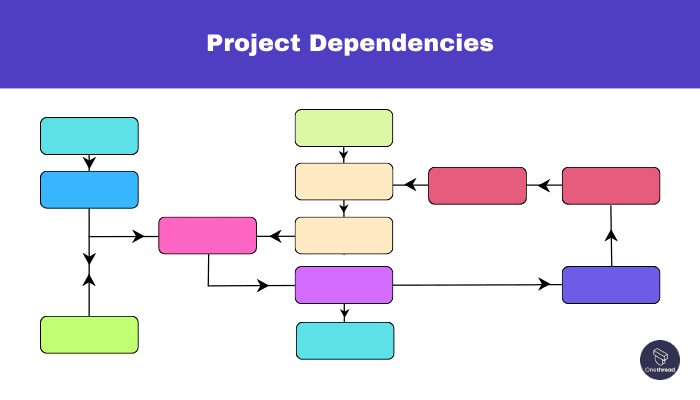
Project dependencies play a crucial role in determining the relationships between tasks or products within a project. By definition, they refer to the dependencies that exist when a specific task requires the completion of another task or set of tasks before it can begin.
In this article, we will explore the significance of project dependencies and the need to understand their management.
Project dependencies can be illustrated through various examples. For instance, in baking a cake, the act of preparing the icing and baking the cake can occur simultaneously, representing independent tasks.
However, baking the cake is dependent on preheating the oven beforehand, establishing a clear dependency between these two tasks. Similarly, in content marketing, publishing a piece of content is reliant on the writers’ team delivering appropriate content for it.
The Importance of Understanding Project Dependencies
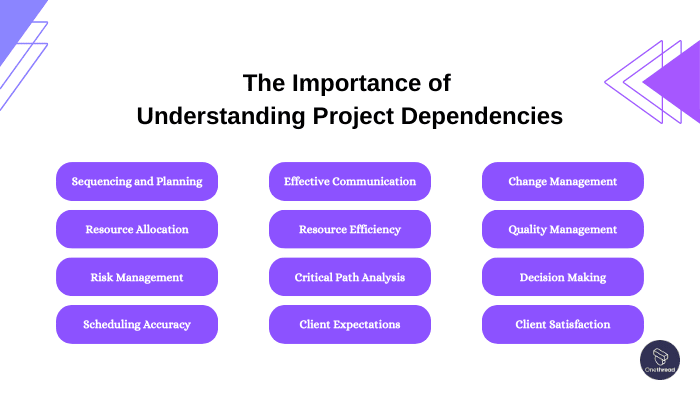



While the existence of project dependencies is evident from the examples provided, it is essential to delve deeper into their significance and why they require thorough examination. In complex or enterprise-level projects, where numerous tasks are involved, overlooking dependencies in project management can have detrimental consequences. Here’s why project dependency demands your attention:
- Sequencing and Planning: Dependencies determine task order, aiding efficient project sequencing.
- Resource Allocation: Clear dependencies ensure optimal resource distribution.
- Risk Management: Identifying dependencies allows proactive risk mitigation.
- Scheduling Accuracy: Dependency awareness leads to realistic and accurate schedules.
- Effective Communication: Team coordination is improved by understanding task interdependencies.
- Resource Efficiency: Dependency comprehension prevents resource conflicts.
- Critical Path Analysis: Accurate critical path identification relies on understanding dependencies.
- Client Expectations: Realistic expectations are set by considering dependencies.
- Change Management: Dependency awareness aids impact assessment during changes.
- Quality Management: Dependencies affect task quality; understanding them prevents rushed work.
- Decision Making: Informed decisions on task prioritization and resource allocation are facilitated.
- Client Satisfaction: On-time, high-quality deliveries enhance client satisfaction.
Potential Challenges and Considerations
When planning projects, it is common to focus on ideal scenarios and overlook potential challenges that could impact task dependencies. It is crucial to contemplate various scenarios and account for unforeseen circumstances. For instance, what if team members fall ill, or the office requires unexpected renovations?
Here are some common challenges that you might face while identifying and managing project dependencies:
- Complexity: Managing numerous dependencies can become intricate.
- Chain Reactions: A change in one task’s timeline can ripple across the project.
- Delays: Dependencies can lead to delays if not managed properly.
- Resource Conflicts: Shared resources can be strained due to dependencies.
- Unclear Ownership: Task ownership might not be well-defined in complex dependencies.
- Dependency Tracking: Monitoring dependencies requires constant attention.
- External Factors: Dependencies might rely on external entities that are beyond control.
- Risk Amplification: A single dependency failure can impact multiple tasks.
- Scope Creep: Unmanaged dependencies can lead to scope expansion.
- Communication: Clear communication is vital to manage dependencies.
- Dependency Errors: Misjudging dependencies can lead to incorrect task sequencing.
- Coordination Challenges: Coordinating tasks across teams requires careful planning.
- Documentation: Maintaining accurate dependency documentation is crucial.
- Change Management: Changes can disrupt established dependencies.
- Over-Reliance: Over-reliance on dependencies can limit flexibility.
- Dependencies Misinterpretation: Misunderstanding dependencies can lead to project setbacks.
Understanding Key Terms Related to Project Dependencies
Before delving deeper into the subject of project dependencies, it is essential to familiarize ourselves with key terms associated with this topic. Understanding these terms will provide a foundation for comprehending the intricacies of dependency project management.
Predecessor & Successor
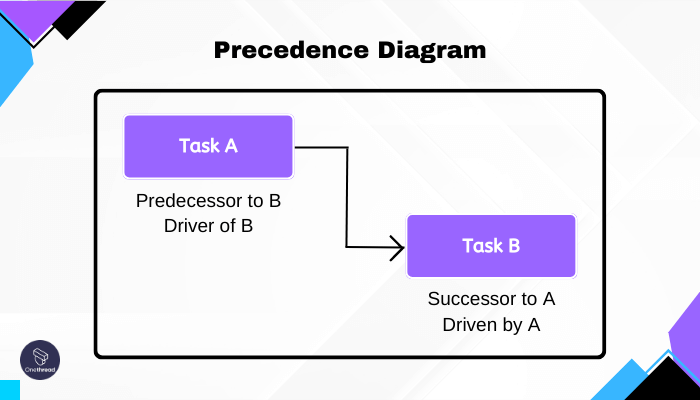



In project management, predecessors are tasks that come before a specific task in a project schedule. Successors, on the other hand, are tasks that come after a specific task. Predecessors and successors help establish task sequences and dependencies, ensuring that tasks are executed in a logical and efficient order to achieve project goals.
Constraints
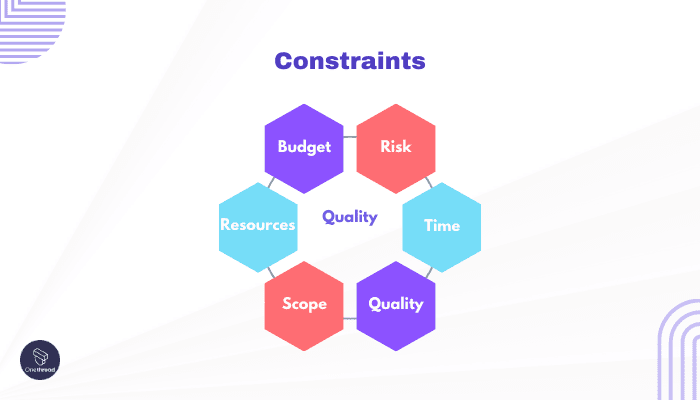



Constraints are inherent restrictions within project management that dictate how tasks and projects should be completed. These constraints typically encompass factors such as cost, project scope, and time. Project dependencies can arise due to these constraints, as they set boundaries within which managers must operate.
Lead and Lag
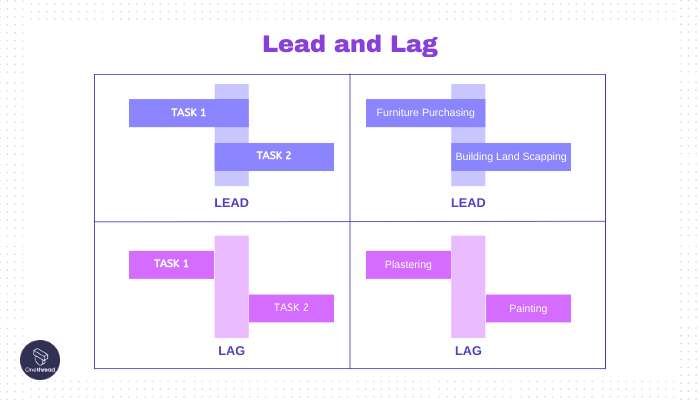



Lead and Lag are two commonly used terms in relation to project dependencies. Lead refers to the amount of time by which a succeeding task can be advanced concerning the preceding task.
This concept applies specifically to tasks connected through a ‘finish to start’ relationship. For example, if Task B is scheduled to start when Task A completes in six days, but Task A finishes in three days, Task B will have a lead time of three days.
Conversely, Lag represents a delay in the start of a succeeding task due to a delay in the completion of the preceding task. Lag is undesirable as it can result in project delays and hinder overall progress.
Float (Slack)
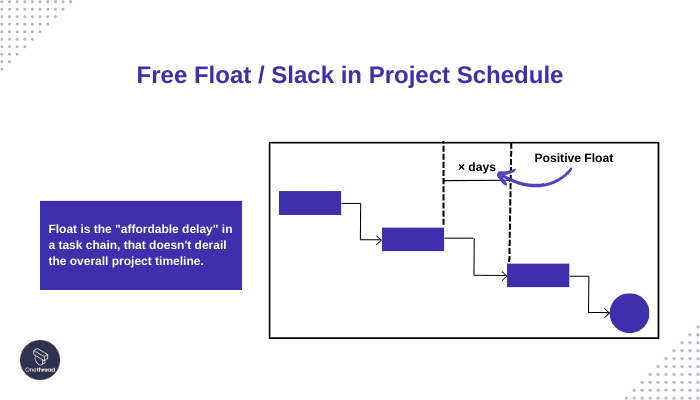



Float, also known as slack, in project management refers to the amount of time that a task can be delayed without causing a delay to subsequent tasks or the project’s overall completion date. It represents the flexibility within a project schedule. There are two types of float:
- Free Float: This refers to the amount of time a task can be delayed without affecting the start date of its succeeding task.
- Total Float: This is the amount of time a task can be delayed without impacting the project’s final completion date.
Float is a critical concept in project scheduling, as it helps project managers understand the degree of flexibility in their project timelines. It allows for better resource allocation and risk management, enabling project teams to optimize schedules without compromising the project’s overall objectives.
Critical Path
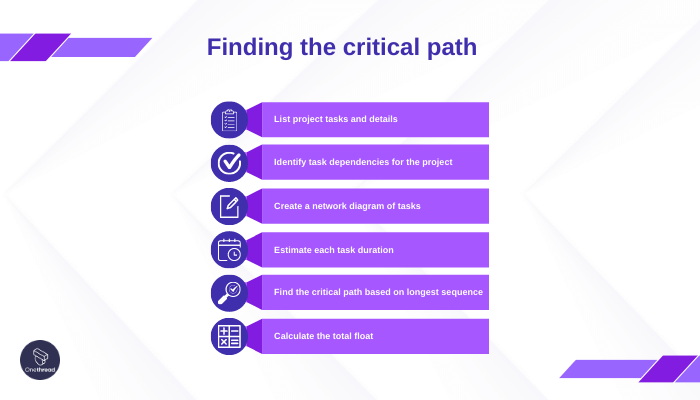



The critical path refers to the sequential chain of task or activities that directly lead to project completion. Any delay or disruption in a task along the critical path can impact the entire chain of events and ultimately affect the project deadline. Identifying and managing the critical path is crucial for project success.
Blockers
Blockers are obstacles or hindrances that impede the timely completion of tasks and projects. These blockers might be internal, originating from within the organization, or external, arising from factors outside the organization. Addressing and overcoming blockers is essential for maintaining project momentum and meeting deadlines.
By familiarizing ourselves with these key terms related to project dependencies, we gain a better understanding of the concepts and challenges involved in managing dependencies within a project. Constraints, lead and lag, critical path, and blockers play significant roles in project execution and require careful consideration for successful project delivery.
Types of Project and Task Dependencies (With Example)
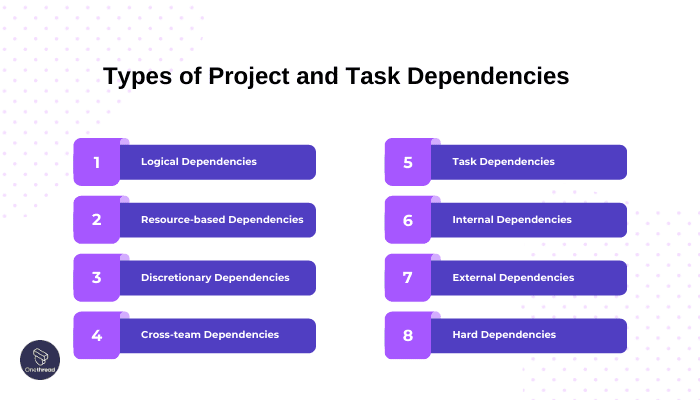



Having explored the concept of project dependencies and key terms associated with them, it is crucial to understand the different types of dependencies that exist in project management.
These dependencies vary based on internal and external factors that influence project execution. In addition, we will also discuss the significance of task dependencies within projects.
Logical Dependencies
Logical or causal dependencies are integral to project management and cannot be avoided. These dependencies occur when tasks have a logical sequence and cannot be performed simultaneously. The completion of a preceding task is necessary before the succeeding task can begin.
Example: Publishing a blog on a website requires it to be written, reviewed, and edited before it is ready for publication.
Resource-based Dependencies
Resource-based dependencies arise when multiple tasks require the same limited resources for completion. In this type of dependency, one task is dependent on the completion of another due to resource constraints.
Example: Two teams need to conduct team meetings, but there is only one meeting room available. Team B must wait for Team A to complete their meeting before they can use the room.
Discretionary Dependencies
Discretionary dependencies, also known as preferred or soft logic dependencies, are not essential for project completion but can enhance the quality of project deliverables. These dependencies are based on the discretion of project teams, stakeholders, and industry best practices.
Example: A blog may undergo review and editing by a content manager before being forwarded to the marketing team for publishing. Although the review process is not mandatory, it ensures error-free content and improves the overall quality of the published blog.
Cross-team Dependencies
Cross-team dependencies commonly occur in large-scale organizations where teams from different departments collaborate to complete a complex project. In such cases, teams depend on each other to achieve a common goal of timely project completion and delivery.
Example: The Chief Marketing Officer collaborates with the digital marketing and content teams to create factually accurate and well-researched content. The digital marketers check the content for structure and SEO friendliness before it is published.
Task Dependencies
Understanding task dependencies is equally important within a project. Task dependencies refer to the relationships and sequencing of individual tasks within a project.
Internal Dependencies
Internal dependencies occur when two tasks or activities within the same project are dependent on each other. These dependencies are under the complete control of the project team and do not involve external parties.
Example: The Quality Analyst team cannot begin testing software until the development process is completed.
External Dependencies
External dependencies are beyond the control of the project team and involve factors outside the project. Non-project activities are performed by external parties, such as clients, vendors, or other external groups, which impact the progress of the project.
Example: A project team cannot start working on a project until they receive approval from the client, who is an external party.
Hard Dependencies
Hard dependencies are rigid and inflexible relationships between tasks. They indicate that the start or finish of one task is directly dependent on the start or finish of another task. In other words, a task cannot start or be completed until its predecessor task is finished. Hard dependencies are often essential and non-negotiable due to technical requirements, safety considerations, or inherent task dependencies.
Example: In construction, pouring the foundation (Task A) must be completed before erecting the walls (Task B). Task B has a hard dependency on Task A.
Understanding Task Dependencies in Project Management
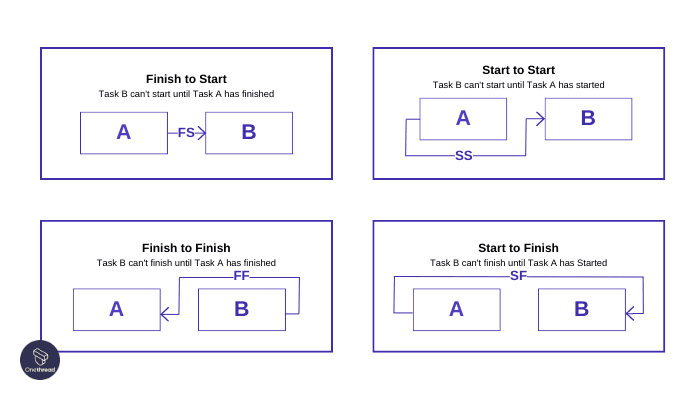



Task dependencies play a crucial role in project management, determining the relationships and sequencing of tasks. By understanding the different types of task dependencies, project managers can effectively plan and execute projects, ensuring smooth workflow and successful outcomes.
Finish to Start (FtS)
This is the most prevalent task dependency, where Task A must be completed before Task B can begin. It represents a sequential relationship.
Finish to Finish (FtF)
Task B cannot be finished until Task A is completed. This type of dependency often applies to tasks with subtasks.
Start to Start (StS)
Task B cannot start until Task A begins. This dependency is suitable for tasks that need to be executed concurrently.
Start to Finish (StF)
Task A cannot be finished until Task B starts. This dependency is essential when there needs to be overlap between tasks. It might involve a specific lag time between starting one task and finishing the other.
Effective Strategies for Managing Project Dependencies
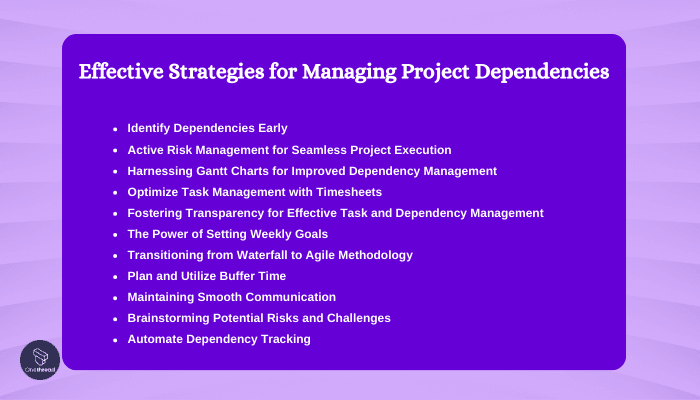



To ensure smooth project execution, proper preparation and planning are essential. Rushing into the execution stage without a solid plan can lead to complications.
It is crucial to take the time to build a foolproof plan and prepare comprehensively. Regardless of dependencies in project management, the goal is to ensure a seamless process and successful project completion. Here are some strategies to achieve this:
1. Identify Dependencies Early
Begin by identifying all task dependencies during the project planning phase. Clearly document these dependencies to ensure a comprehensive understanding among team members.
Create a dependency log or matrix that outlines the relationships between tasks. Include details such as task names, types of dependencies (hard or soft), and reasons for the dependency.
Not all dependencies are equal. Prioritize them based on their impact on the project timeline and overall success. Focus on dependencies that are critical to project milestones.
2. Active Risk Management for Seamless Project Execution
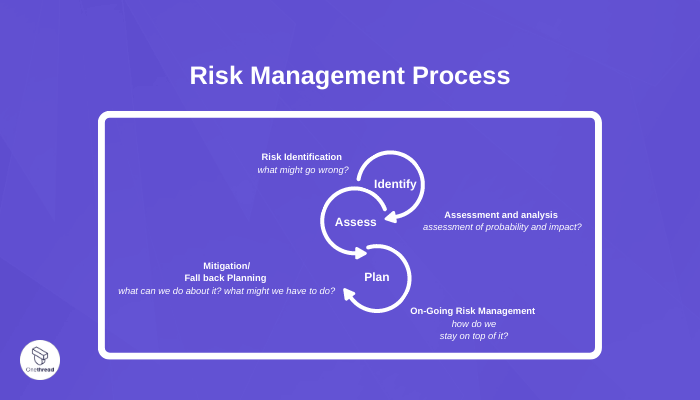



To ensure a smooth project execution, active risk management strategies are essential. By investing in risk management, you can assess, identify, control, and manage potential threats to your project before they occur. Here are some key steps to incorporate effective risk management:
- Utilize Gantt charts: Mapping out your projects using Gantt charts helps visualize and track project dependencies. It provides a comprehensive overview of tasks, deadlines, and the project timeline.
- Employ tracking software: Use tracking software to monitor progress and track time activity, ensuring that everything is on track as planned.
- Assign risk probability and impact: Evaluate the likelihood of risks occurring on a scale of 1-10, and assess the potential impact they may have on specific tasks, especially those with dependencies.
- Estimate and plan for timing risks: Anticipate risks that could significantly impact the project timeline and factor them into your planning.
By incorporating these risk management measures, you can effectively navigate project dependencies and mitigate potential disruptions.
3. Harnessing Gantt Charts for Improved Dependency Management
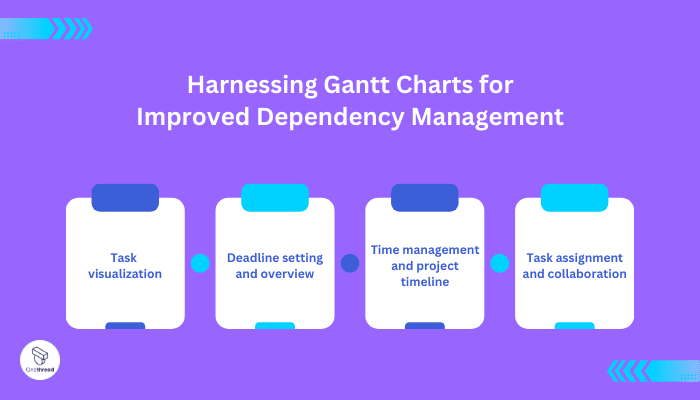



Gantt charts are invaluable tools for managing project dependencies. They provide a visual representation of tasks and enable better planning and coordination. Here’s why Gantt charts work:
- Task visualization: Gantt charts help visualize and organize tasks, allowing for a clear understanding of the project’s structure and interdependencies.
- Deadline setting and overview: With Gantt charts, you can easily set deadlines and gain a bird’s eye view of the entire project, ensuring tasks are completed on time.
- Time management and project timeline: Gantt charts assist in managing time effectively by tracking dependencies and task durations. You can modify schedules and adjust dependencies in project management as needed.
- Task assignment and collaboration: Gantt charts facilitate task assignment to team members and provide quick access to relevant files and feedback, streamlining collaboration.
By utilizing Gantt charts, you can enhance your team’s dependency management and improve project coordination.
4. Optimize Task Management with Timesheets
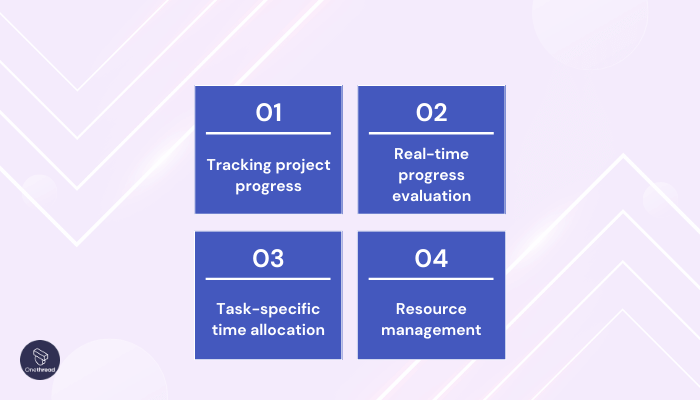



Proper time tracking is crucial for managing discrepancies and project dependencies. Timesheets or time tracking tools allow you to monitor resource allocation and gauge project progress. Here’s how timesheets can benefit your project management:
- Tracking project progress: Timesheets record the time invested in project tasks, providing insights into the overall progress. They help evaluate employee performance and track billable hours.
- Real-time progress evaluation: Comparing real-time progress with initial plans helps identify deviations and enables proactive adjustments for timely project completion.
- Task-specific time allocation: Timesheets reveal the time allocated to specific tasks, allowing you to prioritize and approach those tasks accordingly, ensuring timely completion.
- Resource management: Efficient timesheet usage optimizes resource allocation, ensuring that time is utilized effectively and minimizing potential delays.
By leveraging timesheets and robust time tracking tools, you can manage dependencies in project management more efficiently and ensure adherence to project timelines.
5. Fostering Transparency for Effective Task and Dependency Management
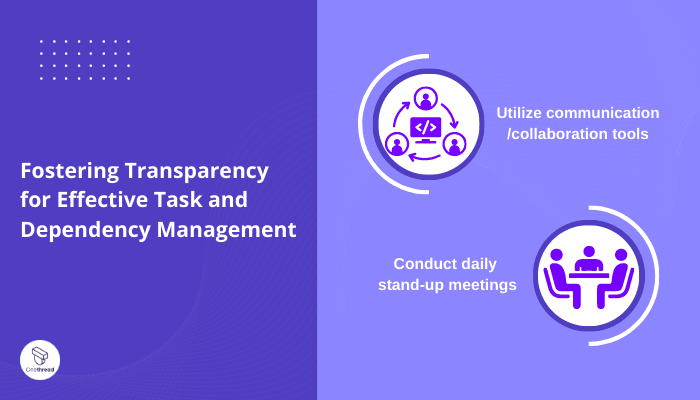



Transparency within teams is crucial for seamless task and dependency management. By fostering an environment of open communication, you can enhance collaboration and productivity. Consider the following steps to promote transparency:
- Utilize communication/collaboration tools: Employing dedicated software platforms like Chanty and Troop Messenger facilitates constant team communication, exchange of ideas, and updates, regardless of whether your team is working remotely or in a shared office space.
- Conduct daily stand-up meetings: Hold short, 15-minute stand-up meetings, particularly within Agile teams following the Scrum framework. These meetings keep the entire team informed about progress, challenges, and pending tasks.
By implementing transparency practices, you can align team members, reduce miscommunication, save time, and improve overall efficiency in managing project dependencies.
6. The Power of Setting Weekly Goals
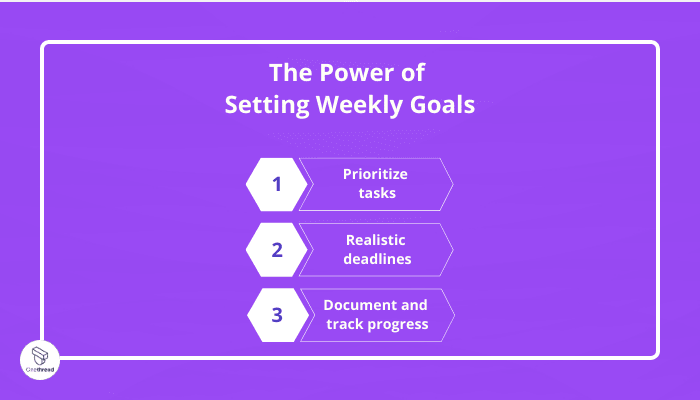



Setting weekly goals plays a pivotal role in managing project dependencies effectively. By breaking down projects into smaller, manageable tasks, you can enhance focus and productivity. Consider the following aspects while setting weekly goals:
- Prioritize tasks: Arrange tasks in order of priority for the upcoming week, ensuring the most critical ones are addressed first.
- Realistic deadlines: Assign realistic deadlines to tasks to ensure their completion within the week, providing a clear timeline for progress.
- Document and track progress: Consistently document and monitor progress to stay on top of tasks and identify any potential delays or dependencies.
By implementing achievable weekly goals, you can streamline project management, minimize dependencies, and maintain a steady workflow.
effective management of project dependencies requires active risk management, the use of visualization tools like Gantt charts, comprehensive time tracking, fostering transparency within teams, and setting realistic weekly goals.
By implementing these strategies, you can navigate project complexities, optimize resource allocation, and ensure successful project completion.
7. Transitioning from Waterfall to Agile Methodology
To reduce bottlenecks and dependencies, consider transitioning from the traditional waterfall methodology to Agile. Unlike waterfall, Agile methodology encourages regular client feedback throughout the project, ensuring it stays on track and minimizing last-minute changes. This transition saves valuable time and resources while ensuring successful project execution and delivery.
8. Plan and Utilize Buffer Time
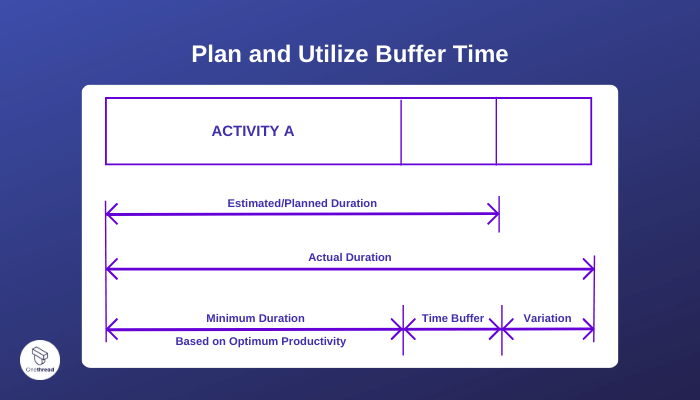



Utilizing buffer time effectively for managing project dependencies involves strategically allocating extra time to tasks that have critical dependencies to mitigate potential delays.
Imagine you’re managing a website development project. One of the critical tasks is “Design Website Interface,” which directly impacts the subsequent task “Develop Website Functionality.”
The design phase depends on the completion of the initial branding phase, which includes creating the logo and selecting the color scheme. Delays in the branding phase could potentially affect the start of the design phase.
Allocating buffer time helps you create a safety net to accommodate potential delays in dependent tasks. This approach prevents a delay in one task from directly affecting the entire project timeline.
9. Maintaining Smooth Communication
Effective project dependency management relies on consistent and transparent communication. Team members, clients, and stakeholders should be kept informed and involved at every stage of the project. Utilize various communication tools, such as instant chat, discussions, real-time updates, and video conferencing, to facilitate timely information exchange, reviews, feedback, and approvals.
10. Brainstorming Potential Risks and Challenges
During project planning, it is essential to conduct a meeting with team members, clients, and stakeholders to identify potential risks and challenges. This collaborative session allows for a diverse range of perspectives, enabling the development of effective solutions to manage project constraints and dependencies. By proactively addressing potential disruptions, you can mitigate their impact on the project.
effective project dependency management requires smart task management using project management software, transitioning to Agile methodology, maintaining smooth communication, and proactive risk assessment. By implementing these strategies, project managers can navigate through complex dependencies and ensure project success.
11. Automate Dependency Tracking
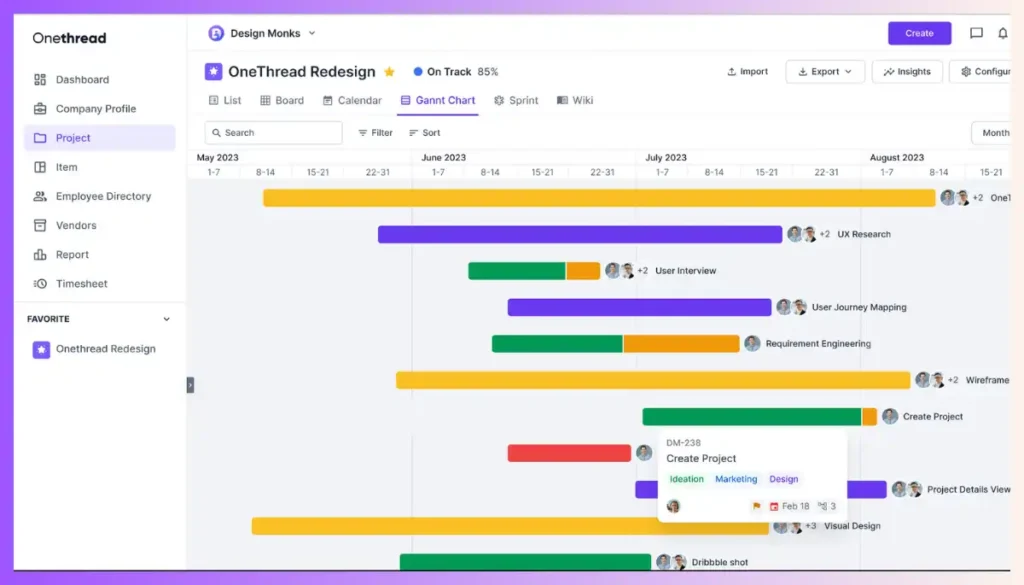

Managing project dependencies requires efficient task management. Utilizing project management software, such as Onethread, can greatly assist project managers in keeping track of tasks and their inter-dependencies. With features like task division, deadline setting, and progress tracking, this software streamlines job responsibilities and promotes transparency within the team.
Step-by-Step Guide: Setting Project Dependencies in Onethread
Setting project dependencies in Onethread enhances task sequencing and ensures smooth project progression. The Dependency Task feature allows you to establish relationships between tasks, indicating their order of completion. Here’s a comprehensive guide to using this feature effectively:
1. Adding Dependency Task in “Blocked by” to a Task
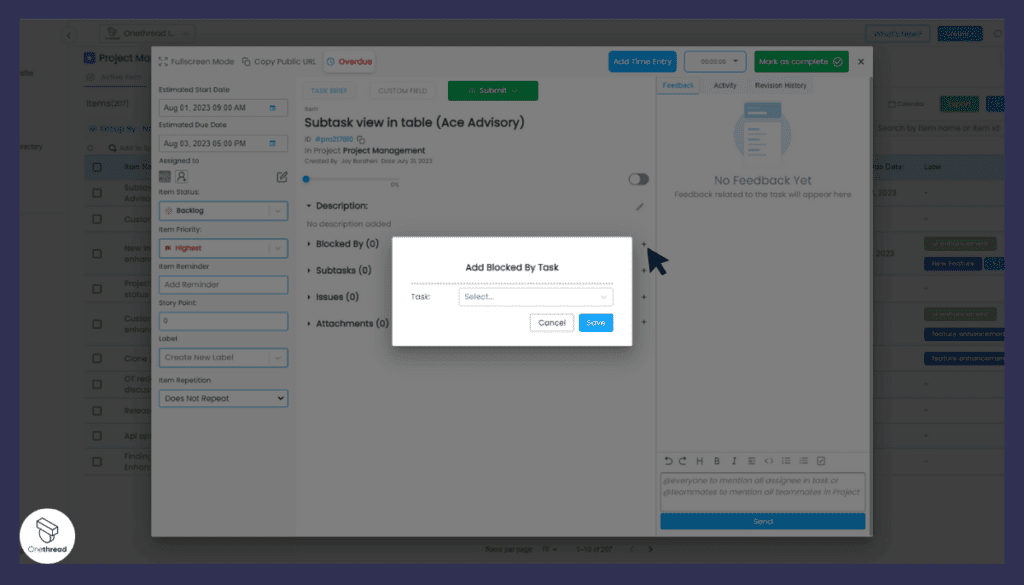



This step creates a dependency where the selected task is blocked by another task. The dependent task cannot proceed until the blocking task is finished.
Pre-conditions:
- At least one dependent task must exist before adding to the “Blocked by” section.
Steps:
- Open the project containing the tasks.
- Select the task for which you want to add a dependency.
- The task modal page will open.
- Click the + button at the right corner of the “Blocked by” section.
- A modal will appear. Click in the description box or the down arrow button.
- A list of tasks will be displayed. Select the desired task from the list or enter its name in the description box to find it.
- You can add multiple tasks by repeating steps 4 to 6.
- After adding the tasks, click the save button to confirm.
2. Removing Dependency Tasks from “Blocked by”
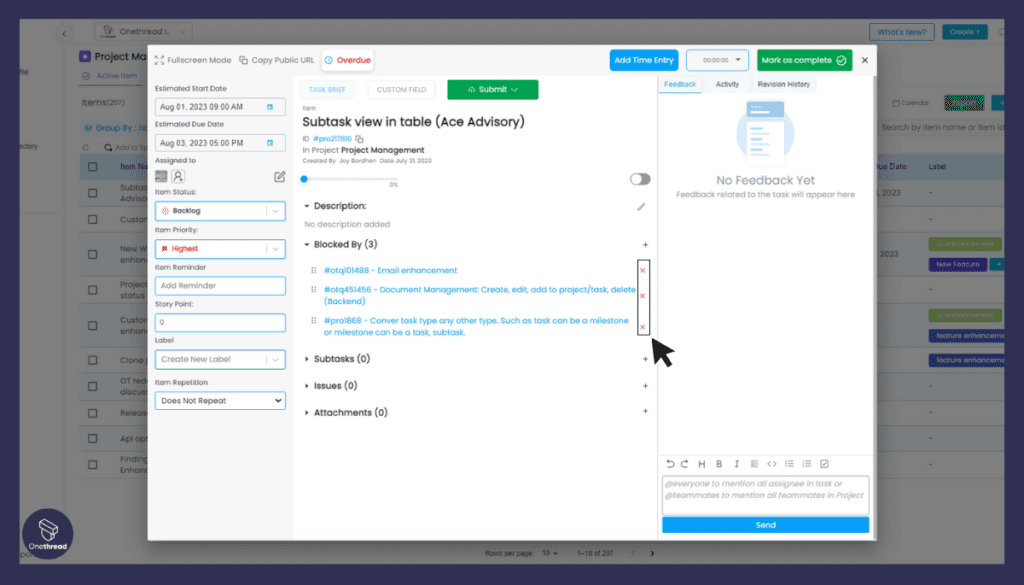



This step removes blocked-by dependencies that are hindering task progress.
Pre-conditions:
- The task must have at least one dependent task added to its “Blocked by” section.
Steps:
- Open the project containing the tasks.
- Select the task from which you want to remove a dependency.
- The task modal page will open.
- Click the down arrow button at the left of the “Blocked by” section.
- A list of added tasks will appear. Select the task you want to remove from the list.
- Click the cross (x) button at the right of the task. The task will be removed.
- You can remove multiple tasks by repeating steps 4 to 6.
By following this step-by-step guide, you’ll effectively utilize the Dependency Task feature in Onethread, enabling seamless task sequencing and optimizing project progression.
Conclusion
In conclusion, project dependencies play a critical role in project management. Understanding and managing these dependencies is vital for successful project execution. By employing strategies such as clear communication, task prioritization, leveraging technology, and proactive risk assessment, project managers can navigate through the complexities of dependencies and achieve project objectives.
Recognizing the interconnected nature of tasks and implementing appropriate management techniques will contribute to the overall success of the project.
Ready to streamline your project dependencies? Discover how Onethread simplifies dependency management, enabling seamless coordination and efficient execution. Take control of your projects today and experience the power of simplified collaboration. Get started now!
FAQs about Project Dependencies
How Do Project Dependencies Impact Risk Management In A Project?
Project dependencies impact risk management in a project by affecting the likelihood and severity of risks. Dependencies can introduce additional complexity and uncertainty, making it more difficult to identify, assess, and mitigate potential risks effectively.
What Are The Key Challenges Faced When Managing Project Dependencies?
The key challenges you face when managing project dependencies include coordinating timelines, resolving conflicts, and ensuring clear communication among teams. It is crucial to track dependencies closely to minimize risks and ensure successful project completion.
How Can Project Dependencies Affect The Overall Project Budget?
Project dependencies can significantly impact the overall project budget by introducing delays, increased costs, and additional resource requirements. These dependencies can disrupt the planned timeline and lead to unforeseen expenses that may strain the project budget.
What Strategies Can Be Implemented To Mitigate The Negative Effects Of Project Dependencies?
To mitigate the negative effects of project dependencies, you can employ strategies such as establishing clear communication channels, creating contingency plans, fostering collaboration among team members, and conducting regular progress assessments.
How Does Effective Stakeholder Management Influence The Handling Of Project Dependencies?
Effective stakeholder management influences the handling of project dependencies by ensuring clear communication, timely decision-making, and alignment of goals. By actively involving stakeholders, conflicts can be resolved and dependencies can be managed more effectively.
